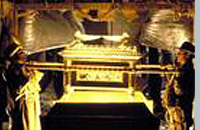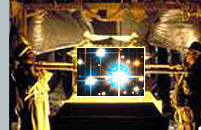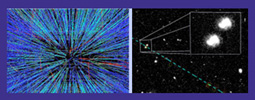 |
||
|
|
 |
|
|
Are There Other Relics to be Found?
Archaeologists excavate to find relics that reveal what ancient civilizations were discovering, creating, fighting over, and what they believed in. Some of the most interesting stories may be lost forever. But in connecting the dots from here to there, archaeologists try to reconstruct history using relics.
BCCP scientists do the same with the universe. The cosmic microwave background (CMB), studied by COBE, MAXIMA, and most recently by WMAP satellite, is one of the most colorful relics that tell us many stories about the universe. Heavy chemical elements are products of stellar explosions that tell stories about how the galaxies evolved. Lighter chemical elements were produced in the Big Bang itself and tell us what the universe was doing when it was only about a minute old. Dark matter may well be relics from the time when the universe was a tenth of a billionth of a second old. Can we go back even further, digging relics from younger universe?
When you cool water, at some point it freezes. This kind of abrupt change in the state of matter is called a phase transition. As the universe cooled, it is very likely that it also went through a series of phase transitions. One we are quite sure about is when the universe became filled with a "dark field" (called the Higgs field) that slows down everything except for light and gravity. Without it, electrons in our body would fly out at light speed and we would fall apart in a nanosecond! We may find relics of this phase transition in the ripples of spacetime, which are called gravitational waves. Physicists also hope that all forces we see in nature can be understood in a single "unified" theory that Einstein dreamed of but couldn't produce. Many candidate unified theories predict more phase transitions in the early universe. Relics from an unimaginably early universe may be stretched across the cosmos, lining up the galaxies. BCCP physicists keep hunting for new relics to learn more about how the universe began and how it changed over time.
Contributed by Hitoshi Murayama Faculty Senior Staff ______________________________________________________________________________________
______________________________________________________________________________________ George Smoot is looking for effects of cosmic strings in the data. Bernard Sadoulet is looking for dark matter relics in an underground laboratory. Hitoshi Murayama thinks dark energy may be connected to a phase transition.
|



 Cosmic Strings
Cosmic Strings